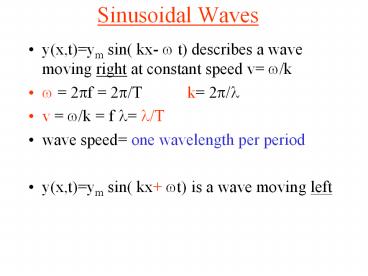Sinusoidal Waves
Title: Sinusoidal Waves
1
Sinusoidal Waves
- y(x,t)ym sin( kx- ? t) describes a wave moving
right at constant speed v ?/k - ? 2?f 2?/T k 2?/?
- v ?/k f ? ?/T
- wave speed one wavelength per period
- y(x,t)ym sin( kx ?t) is a wave moving left
2
Transverse Velocity
- y(x,t)ym sin( kx- ?t)
- uy(x,t) ? y/? t partial derivative with
respect to t - derivative of y with respect to t keeping x
fixed - -ym ? cos( kx- ?t)
- maximum transverse speed is ym ?
- A more general form is y(x,t)ym sin( kx- ?t-?)
- (kx- ?t-?) is the phase of the wave
- two waves with the same phase or phases differing
by 2?n are said to be in phase
3
Phase and Phase Constant
- y(x,t)ym sin( kx- ?t-?) ym sin k(x -?/k) - ?t
ym sin kx- ?(t?/?)
4
Wave speed of a stretched string
- Actual value of v ?/k is determined by the
medium - as wave passes, the particles in the medium
oscillate - medium has both inertia (KE) and elasticity (PE)
- dimensional argument v length/time LT-1
- inertia is the mass of an element ?mass/length
ML-1 - tension F is the elastic character (a force)
MLT-2 - how can we combine tension and mass density to
get units of speed?
5
Wave speed of a stretched string
- v C (F/?)1/2 (MLT-2/ML-1)1/2 L/T
- detailed calculation using 2nd law yields
C1 v (F/?)1/2 - speed depends only on characteristics of string
- independent of the frequency of the wave f due
to source that produced it - once f is determined by the generator, then
- ? v/f vT
6
(a) 2,3,1
(b) 3,(1,2)
7
Summary
- ? 2?f 2?/T k 2?/?
- v ?/k f ? ?/T
- wave speed one wavelength per period
- y(x,t)ym sin( kx- ?t-?) describes a wave moving
right at constant speed v ? /k - y(x,t)ym sin( kx ?t-?) is a wave moving left
- v (F/?)1/2
- F tension ? mass per unit length
8
Waves
F
F
F/2
F/2
v(F/?)1/2
9
Wave Equation
- How are derivatives of y(x,t) with respect to
both x and t related gt wave equation - length of segment is ?x and its mass is m? ?x
- net force in vertical direction is Fsin?2 - Fsin
?1 - but sin? ?tan ? when ? is small
- net vertical force on segment is F(tan?2 - tan
?1 ) - but slope S of string is Stan ? ?y/?x
- net force is F(S2 - S1) F ?S ma ??x?2y/?t2
10
Wave Equation
- F ?S ??x?2y/?t2 force
ma - ?S/?x (?/F)?2y/?t2
- as ?x gt 0, ?S/?x ?S/ ?x ?/ ?x (?y/ ?x)
?2y/?x2 - any function yf(x-vt) or yg(xvt) satisfies
this equation with - v (F/?)1/2
- y(x,t) A sin(kx-?t) is a harmonic wave
11
Energy and Power
- it takes energy to set up a wave on a stretched
string y(x,t)ym sin( kx- ?t) - the wave transports the energy both as kinetic
energy and elastic potential energy - an element of length dx of the string has mass dm
?dx - this element (at some pt x) moves up and down
with varying velocity u dy/dt (keep x fixed!) - this element has kinetic energy dK(1/2)(dm)u2
- u is maximum as element moves through y0
- u is zero when yym
12
Energy and Power
- y(x,t) ym sin( kx- ?t)
- uydy/dt -ym ? cos( kx- ?t) (keep x fixed!)
- dK(1/2)dm uy2 (1/2) ?dx ?2 ym2cos2(kx- ?t)
- kinetic energy of element dx
- potential energy of a segment is work done in
stretching string and depends on the slope dy/dx - when yA the element has its normal length dx
- when y0, the slope dy/dx is largest and the
stretching is maximum - dU F( dl -dx) force times change in
length - both KE and PE are maximum when y0
13
Potential Energy
- Length
- hence dl-dx (1/2) (dy/dx)2 dx
- dU (1/2) F (dy/dx)2 dx potential energy of
element dx - y(x,t) ym sin( kx- ?t)
- dy/dx ym k cos(kx - ? t) keeping t
fixed! - Since F?v2 ??2/k2 we find
- dU(1/2) ?dx ?2ym 2cos2(kx- ? t)
- dK(1/2) ?dx ? 2ym 2cos2(kx- ? t)
- dE ??2ym 2cos2(kx- ?t) dx
- average of cos2 over one period is 1/2
- dEav (1/2) ? ? 2ym 2 dx
14
cos(x)
0.
cos2(x)
.5































